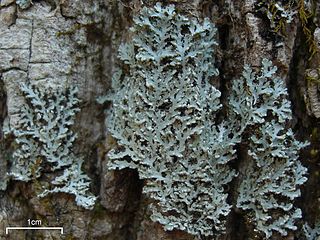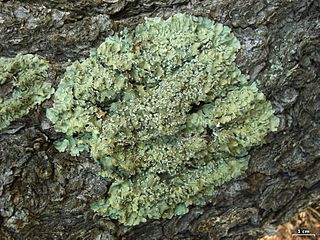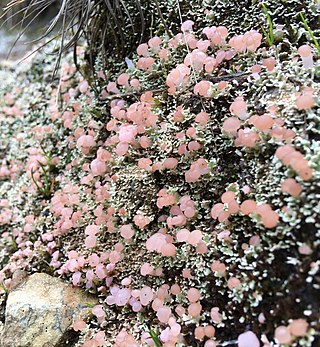
The Physciaceae are a family of mostly lichen-forming fungi belonging to the class Lecanoromycetes in the division Ascomycota. A 2016 estimate placed 19 genera and 601 species in the family.
Septotrapelia is a genus of lichen-forming fungi in the family Pilocarpaceae. It has four species. It was validly published as a genus in 2007 by lichenologists André Aptroot and Jose-Luis Chaves.

Anaptychia is a genus of lichen-forming fungi in the family Physciaceae. Anaptychia species have brown, thin-walled spores with a single septum, and a prosoplechtenchymatous upper cortex.

Heterodermia is a genus of lichenized fungi in the family Physciaceae. The genus has a widespread distribution, especially in tropical regions, and contains about 80 species.

Pyxine is a genus of foliose lichens in the family Caliciaceae. The genus has a widespread distribution in tropical regions.

Flavopunctelia is a genus of foliose lichens in the family Parmeliaceae. The genus contains species that are widespread in temperate and tropical areas. The genus is characterised by broad, yellow-green lobes, point-like (punctiform) pseudocyphellae on the thallus surface, and bifusiform conidia. All species contain usnic acid as a major secondary chemical in the cortex. Flavopunctelia was originally conceived as a subgenus of Punctelia by Hildur Krog in 1982; Mason Hale promoted it to generic status in 1984.

Vainionora is a genus of lichen in the family Lecanoraceae. The genus, which was circumscribed in 1991 by German lichenologist Klaus Kalb, honours the Finnish lichenologist Edvard Vainio, who described the type species as Lecanora pallidostraminea in 1890.
Traponora is a genus of lichen-forming fungi in the family Lecanoraceae. The genus was circumscribed in 2009 by Dutch lichenologist André Aptroot, with the Papua New Guinean Traponora asterella assigned as the type, and at that time, only species. Four newly described species were added to the genus in a 2009 publication, a species formerly in Pyrrhospora was transferred to the genus in 2017, and a new species from Australia added in 2018. Traponora lichens are predominantly from Australasia, with all species but one known to occur in Papua New Guinea.

Absconditella is a genus of lichenised fungi in the family Stictidaceae. The genus was circumscribed in 1965 by Czech lichenologist Antonín Vězda, with Absconditella sphagnorum assigned as the type species. Absconditella is characterised by gyalectoid apothecia with a hymenium that is not amyloid, without a dark pigment and thalli containing green algae as photobionts. The genus name means "hidden", a reference to the scant structure of the thallus and its small apothecia.

Caliciales is an order of mostly lichenized fungi in the class Lecanoromycetes. It consists of two families: Caliciaceae and Physciaceae, which together contain 54 genera and more than 1200 species. The order was circumscribed by American botanist Charles Edwin Bessey in 1907.

Coenogonium is a genus of filamentous lichens in the monotypic family Coenogoniaceae. It has about 90 species. Most species are leaf-dwelling or grow on bark, although a few are known to grow on rocks under certain conditions, and some are restricted to growth on termite nests. The genus was circumscribed in 1820 by German naturalist Christian Gottfried Ehrenberg.

Polyblastidium is a genus of foliose lichens in the family Physciaceae. It has 18 species. The genus was circumscribed by German lichenologist Klaus Kalb in 2015, with Polyblastidium japonicum assigned as the type species. Polyblastidium is similar in morphology to Heterodermia, but its lower surface is cobweb-like in structure (arachnoid), and its ascospores are mostly 1-septate with 1 to 3 sporoblastidia. It is this latter feature that is referenced in the genus name Polyblastidium. The genus contains several species that were formerly classified in the genus Anaptychia.
Klaus Kalb is a German lichenologist and an authority on tropical lichens.

Phyllobaeis is a genus of lichen-forming fungi in the family Baeomycetaceae. It has six species. The genus was circumscribed by lichenologists Klaus Kalb and Claudia Gierl in 1993, with Phyllobaeis imbricata assigned as the type species. Phyllobaeis differs from Baeomyces by the production of the secondary chemical norstictic acid, as well as the tropical distribution of its species. Most species have a squamulose thallus, but the most recent addition to the genus–the Chinese species P. crustacea–has a crustose thallus.
Halegrapha is a genus of lichen-forming fungi in the family Graphidaceae. It has nine species. The genus was circumscribed in 2011 by Eimy Rivas Plata and Robert Lücking, with Halegrapha chimaera assigned as the type species. The generic name honors American lichenologist Mason Hale.
Kashiwadia is a genus of lichen-forming fungi in the family Physciaceae. The genus was circumscribed in Sergey Kondratyuk, László Lőkös, and Jae-Seoun Hur in 2014 to contain the species Physcia orientalis, after molecular phylogenetic analysis showed that the taxon occupied an isolated phylogenetic position in the Physciaceae. An additional five species were added to the genus in 2021. The genus name honours Japanese lichenologist Hiroyuki Kashiwadani, who originally described the type species.
Lichenoverruculina is a fungal genus in the family Hyponectriaceae and order Amphisphaeriales. This is a monotypic genus, containing the single species Lichenoverruculina sigmatospora. which was published in Herzogia vol.24 (2) on page 274 in 2011.
Clandestinotrema is a genus of lichen-forming fungi in the family Graphidaceae. It has 17 species. They typically inhabit montane and cloud forest at higher elevations in the tropics.
Klauskalbia is a genus of lichen-forming fungi in the family Physciaceae. It has four species of foliose lichens.
Pyxine profallax is a species of corticolous (bark-dwelling), foliose lichen in the family Caliciaceae. It is found in Australia, Papua New Guinea, and Thailand.











